Abstract
BACKGROUND AND PURPOSE: Controversy still surrounds the question of when and how to manage cases of subarachnoid hemorrhage of Hunt and Hess grade IV and V aneurysms. Several authors are in favor of surgical treatment, reporting improved clinical outcomes and lower mortality rates. Considering that endovascular procedures are currently being increasingly used to treat aneurysms, we investigated their use in the management of subarachnoid bleeding in a retrospective review of 80 patients.
METHODS: Eighty patients were admitted to our hospital between October 1992 and October 1998 with subarachnoid hemorrhage of Hunt and Hess grade IV and V aneurysms. Patients received standard resuscitation treatment, nimodipine to prevent vasospasm, CSF shunt when necessary, and selective occlusion with Guglielmi detachable coil. They were subsequently followed up for at least 1 year. Aneurysm occlusion was monitored with MR angiography and/or angiography at 6 months and at 1 year.
RESULTS: Of the 80 patients, 42 (52.5%) did well (Glasgow Outcome Scale score of 1 or 2) (62% of the 56 patients with grade IV and 25% of the 24 patients with grade V aneurysms), seven (8.75%) presented with poor neurologic status (Glasgow Outcome Scale score of 3), and 30 (37.5%) died during the first 6 months (26.7% of the patients with grade IV and 62% of the patients with grade V aneurysms). One patient was lost to follow-up. The main causes of death were consequences of initial bleeding in the patients with grade V aneurysms and vasospasm in the patients with grade IV aneurysms.
CONCLUSION: The results are at least as encouraging as the outcomes reported for the surgical series and suggest that early endovascular treatment of high grade hemorrhage is a feasible option, especially because endovascular maneuvers can be performed at any time, even during vasospasm.
- Copyright © American Society of Neuroradiology












